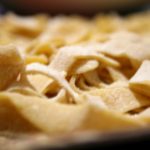
Name
Fresh Pasta
Seal of quality
Typical Food Farming Product (PAT).
Description
Egg- based fresh pasta is a typical Piedmontese dish, which is usually enjoyed as a family meal on Sundays or holidays. It makes use of particular ingredients and is of a particular format which makes use of simple and wholesome ingredients and requires a lengthy and elaborate preparation process which is typical of the cooking procedures of past times.
Agnolotti consists of fresh pasta parcels with a filling, which varies in terms of richness, taste and type according to the various Piedmont regions. They are of a typical squared shape. They consists of two layers of egg pasta which envelope a filling that is based on lean roast veal, eggs, parmesan cheese, salt, pepper and nutmeg, and spinach or cabbage or herbs as required. They are traditionally served with a roast meat sauce, or simply with a knob of butter and sage leaves.

Similar in terms of ingredients but with a different shape are the Plin: which are small irregular egg pasta parcels with a meat based filling. Their name being derived from the simple gesture that housewifes makes to seal off the parcels, which in Italian is: un pizzicotto (a pinch) (“plin” in Piemontese dialect) by pressing down on the pasta with the thumb, the index finger and the middle finger of the hand. Local Piedmont culinary tradition often serves them with a roast meat sauce or with sage and butter.
Tajarin consist of small strips of egg pasta which are similar to tagliatelle in form, of a rich yellow colour due to the abundance of eggs used making it a rich and wholesome dish. The typical combination is with meat sauce, but for connoisseurs, a sprinkling of white Alba truffle is one of the best ways to enjoy this precious “Tuber”.
Ravioles are a typical dish of the Maira and Varaita valleys. Despite their name they do not have the same rectangular shape as Ravioli, but are actually cylindrical in shape, which taper at the sides, their name deriving from the procedure of rolling (raviulè in Piedmontese dialect) pieces of fresh pasta on the worm surface which give them their typical shape. As they are a typical product of mountain hamlets typical ingredients of this zone are used such as cheeses and potatoes. The pasta mixture infact incorporating mashed boiled potatoes and cheese such as Toumin dal Mel for example. They are traditionally served with a cheese sauce (Castelmagno cheese) or with a sauce made using fried butter and cream.

Area of production
- Agnolotti are produced throughout the entire province of Cuneo and all over Piedmont.
- Plin are produced in the province of Cuneo (especially in the Langhe), in the upper Monferrato zone of Alessandra and Asti and in some of the communes of the province of Turin.
- Tajarin are typical of the Langhe and Monferrato, even if actually produced all over Piedmont.
- Ravioles are produced in mountain areas and particularly in the Maira and Varaita valleys.
History
All dishes based on fresh egg pasta, are dishes enjoyed as a family meal either on Sundays or on various religious festivities. Each individual area and town has its own variations and each housewife adds her own personal touch. The names given to these dishes is in Piemontese dialect as in the case of Tajarin, which in Piedmont dialect signifies tagliolini, dei Plin o delle Ravioles the former being in Langhe dialect and the second being in Provencal but which both refer to the method of preparation of these dishes. While the term “Agnolotti” is of uncertain origin, some believing that it comes from the Parma dialect “anolino”, so-called because of its dimensions, almost as large as a true Matrimoniale, which is a kind of sheep taken to the anulare, while others claim that it has been named after a chef of the Monferrato who was called Angelotu (Angiolino). His speciality dish, “Piat d’Angelot”, gradually becomig “Agnolot”.






